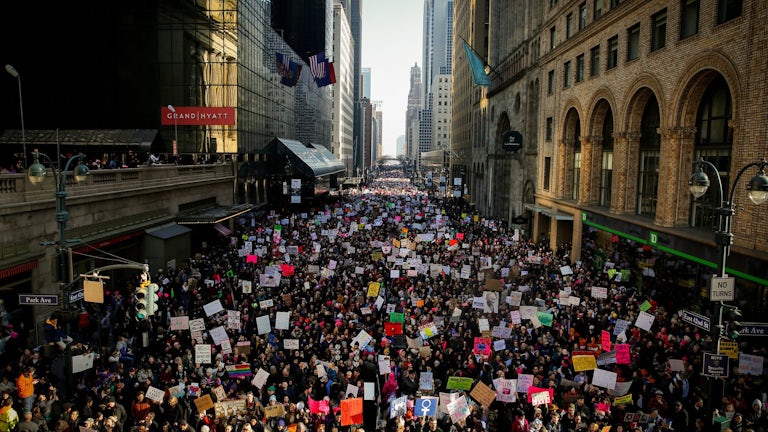Shopping Bag (0)
Your shopping bag is empty


(When it comes to marketing, at least)
What can marketing learn from populism?
Dust off your history anthology – we’re diving into populism. We’ve seen a wave – scratch that, a tsunami of “for the people” rhetoric across news channels, on placards and all over our social media feeds. Brexit, the shocking U.S. election result, swiftly followed by a near-miss for right-wing National Front leader Marine Le Pen in the French Presidential elections – it’s been one right turn after another.
It makes for compelling (and sometimes nail-biting) viewing – but what all this noise can truly teach us are some lessons about marketing to the many.
Sensationalism – we’ve seen bags of it: “350 million a week to the NHS”, “Build the Wall!” and Holocaust denial are just a handful of enthralling news headlines generated by populist parties and their leaders over the past 12 months. They’re masters of using terms that stick (“fake news!”), and using them lots, as well as touting ideas so outrageous they have to be repeated.
Repetition is key here – keeping your brand in the conversation comes naturally when you’re retweeting, reposting and constantly sharing your ideas. Speaking to your audience on their platform is also a killer move – just look at now legendary @realDonaldTrump. Although a figure of ridicule, he soon drummed up his support through his prolific use of Twitter, and soon gained a disproportionate amount of airtime compared to other candidates. This, in all likelihood, significantly improved his chances of success by having his outrageous messages repeated by newsreaders, candidates and channels across the country.
We’re practicing what we preach and repeating this point twice. Clear, consistent and single-minded messaging is easy to remember and even easier to repeat. “Lock her up” and “Drain the swamp” were chanted, endlessly, during the U.S. Presidential Election Campaign, especially if the mantra is actionable.
Rallies are a wonderful way for populist candidates to boast of the support they’ve garnered. Not only are you showcasing real people power by holding an in-person event, you’re helping spread your message by bringing those who align with your brand together.
Real-life events are an impactful way to show an adience you’re plugged into their narrative – and are a part of it too! Think Nigel Farage proffering a pint, or Trump with the now-infamous red trucker cap on his head amongst a sea of everyday folk wearing the same item.
Before sculpting a campaign of any kind it pays to do your research and figure out how to tap into real emotion. Knowing your audience is key, but perhaps more importantly is knowing your place in their world. Pepsi showed us how a first class sentiment screw up can play out across the globe – not only did their tone-deaf message offend millennials, it also offended, well, pretty much everyone else, meaning they were ridiculed from every angle possible.
Successful candidates and parties – like UKIP, Trump and Le Pen – didn’t shun the disenfranchised. Instead they put them on pedestals and made them feel listened to. This oft-ignored audience makes up a sizeable chunk of the population, and finding support from someone who’s got a chance of power is a comfort if you feel no one else is looking out for you.
Manifesto to Mandate
Have the goods to back up your claims - or risk damaging your brand forever. Just check out Trump’s first 100 days when compared with his campaign promises.
Don't be a one-trick pony
UKIP have been tainted by this problem – their singular brand objective means that now they’re hugely lacking in direction – there’s a reason why a marketing pipeline is key when developing a brand.
And finally, never assume...
Your audience isn’t going to be the same everywhere – so don’t create a one-size-fits-all marketing strategy. We delved deep into the minds of young people in the UK today in our Young Blood series and found, perhaps unsurprisingly, that they’re the most liberal audience in the country. However, hop the Channel and the surveys tell a different story.
In April 2017, Al Jazeera reported the largest demographic for National Front support comes from voters aged between 18 and 24, where Le Pen polls at 40 percent. This is a stark contrast to what we see in the UK - with the French figure largely driven by youth unemployment and a desperate desire for change.
Do your homework. Regularly profile your audience. Know what effect wider world events are having on them. Make your brand matter. And never cast Kendall Jenner in an ad.